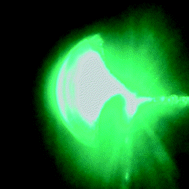We report on the laser and sunlight driven, fast and large oscillation of cantilevers composed of photoresponsive liquid crystal polymer materials. The oscillation frequency, driven with a focused 100 mW laser of multiple wavelengths (457, 488, 514 nm), is as high as 270 Hz and is shown to be strongly correlated to the physical dimensions of the cantilever. The experimental frequency response is accurately described by the calculated natural resonant frequency for a non-damped cantilever. To further understand the conversion efficiency of light energy to mechanical work in the system, the oscillatory behavior of a 2.7 mm × 0.7 mm × 0.04 mm cantilever was examined at pressures ranging from 1 atm to 0.03 atm. A large increase in amplitude from 110° at STP to 250° at low pressure was observed. A first approximation of the system efficiency was calculated at 0.1%. The large increase in amplitude at low pressure indicates strong hydrodynamic loss and thus, the material efficiency is potentially much greater. Using a simple optical setup, oscillatory behavior was also demonstrated using sunlight. This work indicates the potential for remotely triggered photoactuation of photoresponsive polymer cantilevers from long distances with lasers or focused sunlight.

You have access to this article
 Please wait while we load your content...
Something went wrong. Try again?
Please wait while we load your content...
Something went wrong. Try again?


 Please wait while we load your content...
Please wait while we load your content...